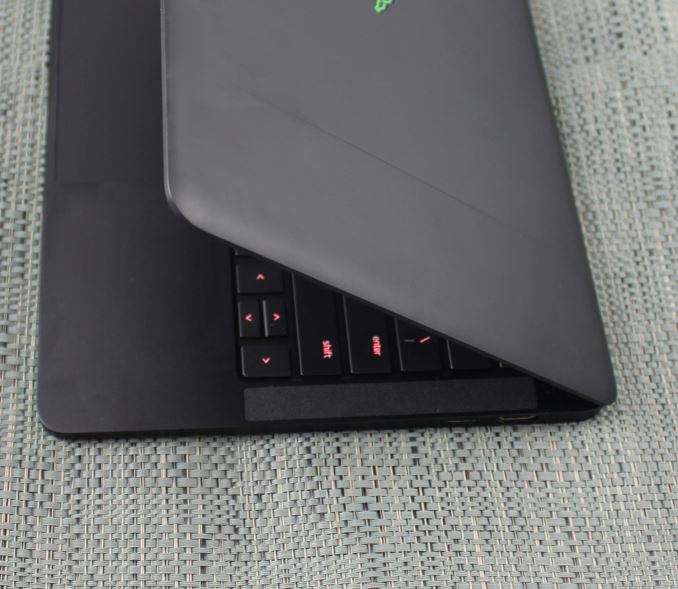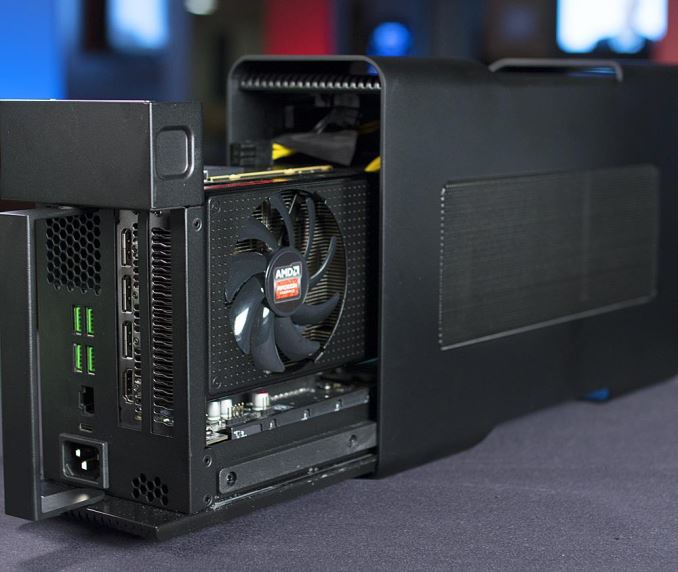The Razer Blade Stealth Review: Razer Takes On The Ultrabook
by Brett Howse on March 29, 2016 8:00 AM EST- Posted in
- Laptops
- Razer
- Skylake
- Razer Blade Stealth
- eGFX
- Razer Core
- Skylake-U
Final Words
So what is the verdict on Razer’s first step into the Ultrabook world. As with most devices, they’ve done some things well, some things great, and some things not so great. The first great part is the design. The Stealth is basically a mini-version of the Blade 14, with an almost identical look and feel. The matte black finish looks wonderful on the CNC aluminum chassis, at least until it gets a few fingerprints. Razer has put their same hidden cooling vent into the hinge of the notebook, concealing it from view for a cleaner overall look, and other than the green Razer light-up logo, the design is very understated which is something that has its own appeal.
The keyboard is a marvel of engineering. Razer is certainly not the first company to do a backlit notebook keyboard, or even a backlit keyboard that can change color, but they are the first to do individual backlit RGB keys on an Ultrabook, and the result is spectacular. The Razer software lets you pick several stock options for colors and patterns, or you can use the Chroma Configurator to set pretty much anything you want. It is completely customizable, and this is something that’s been on the desktop space for some time, and it’s great to see it come to the notebook.
Razer has also outfitted the Stealth with one of the highest density displays around. Packing a UHD resolution into a 12.5-inch panel may seem like overkill, but side by side with the QHD version the difference is very apparent. It is also a full Adobe RGB gamut panel, which has an up-side in a much wider color gamut, but is also a downside due to the lack of good software support from Windows.
The performance of the Intel Core i7-6500U CPU is very good, and with the Stealth there are no lower tiers in terms of performance. Most devices charge a lot more for the Core i7 model, so it’s great to see Razer include it across all models. I do feel that an Iris based processor would have been nice, even as a more expensive option, but that is not in the cards with the first generation, at least for now. Otherwise the 8 GB of RAM is adequate for today, but with Skylake’s support of DDR4, 16 GB of RAM in an Ultrabook is quickly becoming the new normal. Storage performance is very good across the range, with all Stealths coming with NVMe PCIe storage. It’s a slower TLC SSD, but it still outclasses the SATA drives of last year.
Meanwhile Razer has also put a lot of engineering into the Stealth so that it could be used in conjunction with the Razer Core. This will be the world’s first external graphics dock over Thunderbolt 3, and they had to work closely with the entire Windows ecosystem crew – AMD, NVIDIA, Intel, and Microsoft – to enable this functionality in as seamless a method as possible. The Core is coming out this month, and will give a single-cable docking solution to significantly increase the graphical power of this device. At CES, I was able to see the Stealth attached to Core running Fallout 4, and it was a great experience. That said, I’m curious to see how much the U series processors hold back a really fast GPU, but regardless the experience is going to be a lot better than the limited graphics power you can fit in an Ultrabook.
In terms of construction, the Razer Blade Stealth really has everything done well. A great aluminum chassis, a thin and light design, and a top notch display. It has a great new keyboard lighting system, and support for external graphics over Thunderbolt 3. It even uses USB-C as the charging port, meaning the same cable that can charge your phone can charge the Stealth. There’s just one issue with it, and unfortunately it’s a big one.
Simply put, the battery life of the Stealth is not up to snuff with the rest of the Ultrabook competition. I knew going in that a UHD display with Adobe RGB support was going to hit the battery life hard, but I was a bit surprised just how poorly it fared. Even switching out displays for the lower-resolution sRGB QHD panel can't fully close the gap. If Razer wants to compete against the big OEMs in the Ultrabook space, they need to look at every single component in the Stealth, and find ways to save power on all of them. Eight hours is really the minimum on our light test for 2016, and even the QHD version falls well short of that.
It's really too bad, because the rest of the Stealth is a top notch laptop. Which does't have us writing off the laptop entirely – there are plenty of cases where it might still be a great machine – but if any scenario involves long periods away from a power outlet, it’s going to be an issue. Sure you can supplant it with USB battery packs, or find a place to plug in, but that’s not always a practical option.
Ultimately the Razer Blade Stealth is so close to being an awesome Ultrabook. If you don’t need battery life, you’ll want to check it out, but if you do value longer run times off of the battery, the Stealth is likely not the laptop for you.












66 Comments
View All Comments
bug77 - Wednesday, March 30, 2016 - link
Hear, hear!My desktop has it's place and is the only device I game on (save for PvZ2 on my old tablet).
lmcd - Tuesday, March 29, 2016 - link
While the battery life isn't mind-blowing, I wish the storage tiers went 900-1100-1300-1500. Six hour battery life, while bad by comparison, is still more than the average person's working time away from the desk and wouldn't limit most of the people interested in this.jcbenten - Tuesday, March 29, 2016 - link
The thick bezel makes it look old. After seeing the XPS and Surface Book I could not stand to look at this screen.nagi603 - Tuesday, March 29, 2016 - link
Yeah, that bezel looks thicker than that of my old 2004 gaming laptop...Naql99 - Tuesday, March 29, 2016 - link
I bought one of these for my son. First power adapter was defective out of the box. The usb-c connector would not 'snap' into place. Returned it and the replacement unit broke in about 2 weeks when the tip fell out of the end of the cable. I assumed my son was at fault, so I purchased another for the princely sum of $140. The tip fell out of that one within 3 days. Razer refused to replacement. Well, sorry, but cannot afford to keep shelling out $140 a pop for charging bricks and they clearly have a build quality defect. Sure, the colored backlit keys are pretty, but Razer quality is sub-par and their support let me down. We ended up buying an Innergie charger for $40 that works, even though Razer support warned me that using it instead of their crappy $140 chargers would 'void my warranty'. Ok, your warranty isn't worth squat. May I recommend the dell xps precision laptops which are also eGPU capable. As for the Core, it does not even offer a thunderbolt pass-thru, so how can that be considered an actual docking unit. There will be other eGPU solutions soon. I would wait. Buyer beware. Out of the two months my kid has had it, he's only been able to use it for maybe 2 weeks.DanNeely - Tuesday, March 29, 2016 - link
It has a bunch of USB ports, an ethernet port, and a bunch of video out ports. That looks like a standard docking station to me. If I were to criticize it for anything, a lack of audio ports would be my biggest grumble.Not including TBs optional passthrough feature was probably a deliberate decision to limit competition for bandwidth the GPU needs. An x4 PCIe connection is enough that most games will run at almost full speed; only an x1 will strangle a large fraction of them. Even with just USB+ethernet you could end up oversaturating TB3: 32gb for PCIe, + 4x 5gb for USB3 + 1gb for ethernet is 53 gb vs TB3's 40gb. In practice that's unlikely to be a major concern; not least because 1 or more of the USB ports would typically be filled with low bandwidth devices (keyboard, mouse, usb headset); and USB3 devices capable of maxing the bus speed for sustained periods of time are relatively uncommon. Chaining a second high bandwidth TB device OTOH could be problematic; giving it half the total bandwidth would hurt the GPU in a significant number of games. Things that would fall under the category of "clever^H^H^H^H^H^Hstupid user tricks" like chaining a TB3 monitor and having it run off the laptops IGP (either due to misconfiguration, or not having video pass through support for the docs GPU due to cost or hardware limitations) could also end up burning people.
IMO with GPUs in the mix any sort of daisy chaining would need to wait for a future standard that supports at least 8x PCIe.
Naql99 - Tuesday, March 29, 2016 - link
I see your point, but I have a significant number of thunderbolt devices. I need to be able to hook up my external disks. In general, it is frustrating that there are so many thunderbolt devices that insist on being the the last device in the chain. In any case, I would have purchased the Core, if not for the support/wuality issues noted above.jsntech - Tuesday, March 29, 2016 - link
Razer has made enough missteps for me (Synapse 2.0, numerous failed devices which were very gently used) that despite the decent form factor competing pretty nicely with rMBP 13 and such, I won't even consider it (not to mention 16:9 is *especially* poorly suited on a 12.5" display).jsntech - Tuesday, March 29, 2016 - link
Er, the MB is probably a better comparison.TheinsanegamerN - Tuesday, March 29, 2016 - link
For that price, I would have expected for them to use the i7 6560u with the iris 540 gpu, and have better battery life. This thing is just a normal uber expensive ultrabook without the dock, at least with iris it could stand on its own a bit.